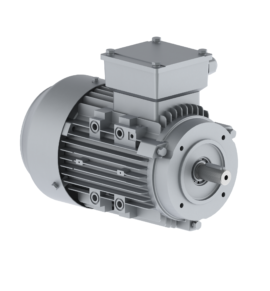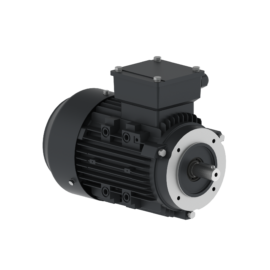The mechanical size of the engine
The mechanical size of the motor is the dimension from the motor axis to the plane of the motor base (mounting feet). This dimension is often called a motor lift.
The mechanical size corresponds to the constant diameters of the rollers.
Induction motors of alternating current and some direct currents have standardized motor connections, e.g.
The 0,37-1400 engine will definitely have a diameter shaft fi14 and one of the 3 motor flanges B14 B14B or B5
The most popular collars on the market are B5 and B14. Motors with such flanges are available in large quantities from the warehouse.
B14B medium flanges sometimes called B14 / 1 are less popular.
Sometimes it happens that engines with the same horsepower and speed come in two different sizes. These smaller ones are referred to as motors in a reinforced housing. They are standard in a larger housing, but they are also available in a small version.
When placing an order or request for quotation, specify the motor connection specifying the mechanical size and flange size, eg 71B14 or by providing a motor connection: flange diameter and shaft diameter of the 105 / 14 motor
The table below shows which motors are present in a given mechanical size. It allows you to identify the engine.
Transmission and motor connection - measurements
The transmission connection defines the diameter of the hole in the drive axis and the diameter of the collar. The motor connection defines the diameter of the shaft and the diameter of the flange. In order for the transmission to be connected to a given motor, its connection must match the motor connection, which means that the diameters of the gearbox and motor shaft have to be of the same diameter and the diameters of the flanges must have the same diameters. It happens that a gear with a smaller shaft is fitted with a gear opening with one degree more, using a so-called reduction sleeve. However, motor flanges must have absolutely identical diameters. Reduction sleeves are widely used to speed up the order.
Insulation class
In all presented engines, class F insulation is used (operating temperature up to 155 ° C).
All motors with non-fractional power have temperature sensors built into the windings which, when using the correct electromagnetic switch, allows the motor to be switched off automatically if the permissible winding temperature is exceeded.
Motors of size 80 and larger are equipped with a PTC sensor
The insulation system of these motors allows them to be powered by a current frequency converter (inverter).
Level of security
The motors offered have an IP55 degree of protection according to EN 60034, which means that the motors are resistant to the penetration of dust in quantities that interfere with their work and the flow of water from any direction.
Engine construction
160 mechanical motors are in aluminum housings. In turn, the motors from the mechanical size 180 are made in a cast iron housing.
The bodies have such a construction that allows the configuration of the motor with a terminal box located on the top, on the right or on the left. As standard, the motors are delivered with a terminal box at the top.
Łożyska
Motors up to the mechanical size 180 are equipped with indoor bearings (ZZ or 2RS) and require no maintenance. In contrast, motors from the size of the mech. 200 are equipped with grease nipples. The lubricant should be topped up in accordance with the attached technical documentation.
Cooling
In the standard engine, the cooling function is performed by a fan mounted on the shaft and covered by a perforated cover. Due to the fact that the fan is mounted directly on the motor shaft, the cooling efficiency is closely related to the rotational speed of the shaft.
Engines designed to work with inverters whose rotational speeds will be lowered below 700 rev / min should be equipped with an independent cooling system (so-called external cooling). Thanks to this solution, the engine cooling intensity is constant and independent of its rotational speed.
Efficiency of IE1, IE2, IE3
The efficiency of the electric motor is the ratio of the mechanical power given to the motor shaft to the electric power consumed by the motor. Electricity that is not converted into mechanical energy causes losses. To reduce these losses and increase the efficiency of the engine, its design and materials are optimized.
In European Union countries, legal regulations regarding the efficiency of low-voltage electric motors have been introduced. In 2009, the European Commission published the (EU) Regulation 640 / 2009, also known as EU MEPS (Minimal Efficiency Performance Standard). The regulation established:
- the subject and scope of the engines covered by the regulations,
- levels and efficiency classes (IE1, IE2, IE3, IE4),
- the method of determining efficiency on the rating plates,
- the timetable for implementing the directive.
Exclusions:
- engines equipped with a variable speed controller (with inverter),
- braked engines,
- explosion-proof motors,
- 700rpm engines,
- engines designed to work:
• in full immersion in liquid,
• at altitudes above 4000m above sea level,
• at an ambient temperature above 60 ° C,
• at ambient temperatures below -30 ° C,
• other according to the regulation.
ORDINANCE:
https://publications.europa.eu/en/publication-detail/-/publication/2f6abfe6-6030-42ae-8ce5-90e0e327b8fc/language-pl



